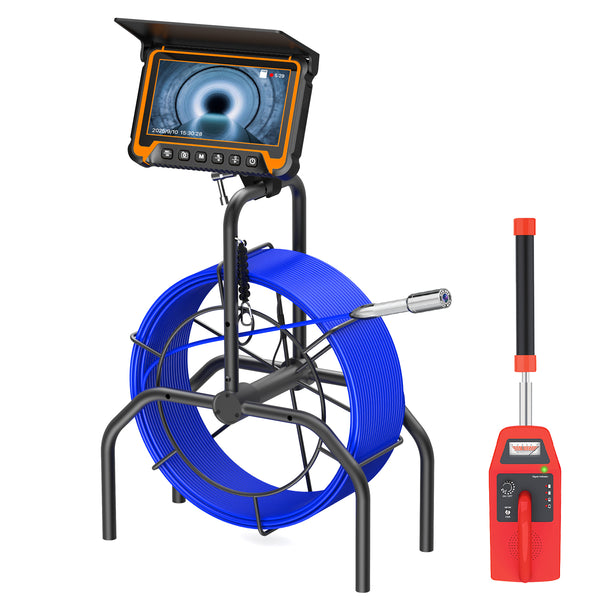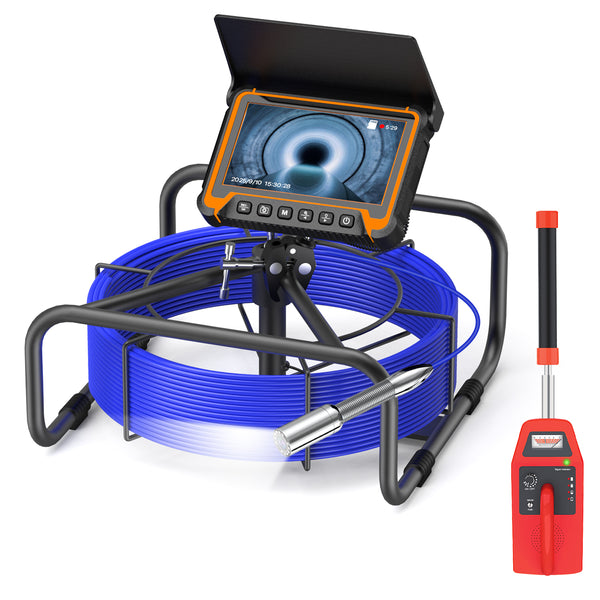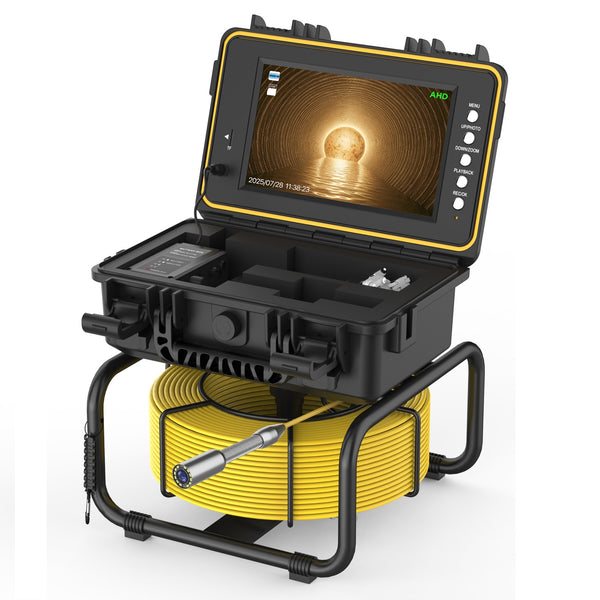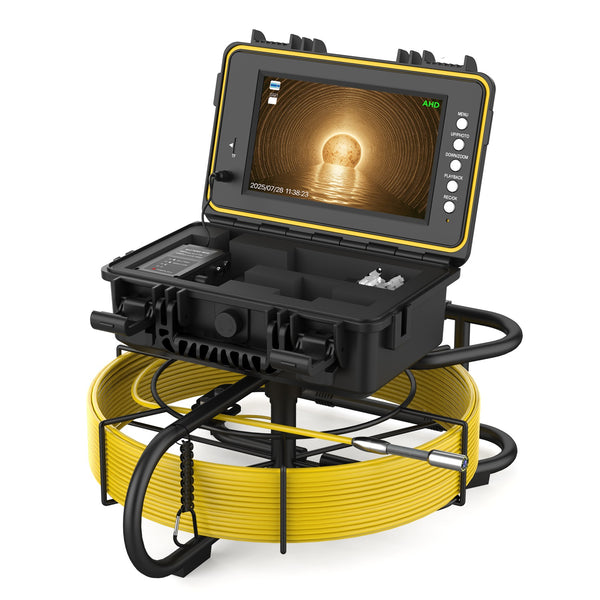
Kitchen Drain Inspection & Diagnosis
Identify blockages, grease build-up, or misaligned joints using a sewer camera and a 512 Hz underground locator.
Common Symptoms & What They Mean
- Slow drain / recurring clogs — grease build-up, sags (bellies), intrusions, or offsets.
- Odor from the sink — stagnant water in low spots or a dry trap.
- Gurgling noises — venting issues or downstream partial blockage.
How Do I Clear a Clogged Kitchen Sink?
Goal: clear the blockage you saw on camera, clean the pipe wall, and flush out residue so it doesn’t reform in days.
- Reassemble (loosely) after inspection: If you removed the trap, reassemble with good washers. Hand-tighten first; you’ll snug it later.
- Cable the line (mechanical first): Feed a ¼–⅜-in hand auger into the wall stub. Rotate while advancing; don’t ram elbows. When resistance softens, you’re chewing through grease or starch. Pull back, wipe the cable, then pass again to smooth the bore.
- Hot, soapy flush: Fill the sink with very hot water and a small squeeze of regular dish soap. Pull the stopper to send a pressurized slug through the now-open line. The soap lubricates and carries fines downstream.
- Camera verify: Look again. You want a round, clean opening with no dangling mats and no “shelf” of sludge. If you still see a greasy band, repeat a gentle cable pass and flush once more.
- Disposal reset and best practices: Run cold water while operating the disposal (it keeps fats firm so the impellers grind them smaller), then finish with a long hot-water rinse to move everything out of the branch.
- Maintenance (non-emergency): Enzyme/bio cleaners are for prevention, not for tonight’s plug. Use them per label once the line is mechanically clean.
What If the Camera Showed a Belly?
You can clear the clog today, but you’ll need to resupport and re-slope that run or replace the dipped section. Otherwise, debris will settle there again.
When Do You Need Professional Help?
- Recurring clogs within days or weeks despite doing a proper mechanical clear and hot flush.
- Standing water on camera you can’t keep the lens above—that’s a belly needing re-slope or replacement.
- Visible offset, cracked fitting, or crushed section on camera.
- Multiple fixtures backing up (kitchen plus laundry or tub), pointing to a downstream/main issue.
- Persistent sewer gas smell or gurgling after the pipe looks clear—likely a vent problem or failed AAV.
- You’re not comfortable opening traps, working around a disposal, or using a cable.
Tip: Show the plumber your camera footage and the distance where you found issues. It shortens the diagnosis and keeps quotes accurate.
Summary
Kitchen sinks clog for five predictable reasons: grease film, sticky food scraps, soap/mineral roughness, slope defects, and venting problems. A drain camera turns guesswork into a clear plan by showing the clog’s location, material, and mechanical context (belly, offset, clean but air-starved).
Use that intel to choose the right fix: clean the trap, cable the exact spot, flush hot and soapy, and correct any slope or venting defect. With a small camera and steady habits—small batches at the disposal, long rinses, starches, and fibers in the trash—you break the cycle of “clog—quick fix—clog again.”
FAQ
1) Why Does Boiling Water Help, But Only for a Day or two?
Boiling water melts the surface of a grease plug but doesn’t remove the film on the pipe wall. That thin film immediately catches new debris. You need a mechanical clear (auger) and a long hot-soapy flush, then better disposal habits.
2) Is a Drain Camera Really Necessary for a Kitchen Sink?
You can clear many clogs without one, but a plumbing camera answers three costly questions in minutes: where exactly is it, what is it, and is there a slope/vent issue? That prevents wasted time and needless wall cuts.
3) What Size Drain Camera is Best for Kitchens?
A 17–23 mm head on a 50–100 ft cable is ideal. It navigates traps and elbows, and the length covers most home branches.
4) Do Chemical Drain Openers Work?
They sometimes burn a tiny channel through soft clogs, but they’re risky (heat and fumes), can damage finishes, and make later mechanical work dangerous. If chemicals were used, tell any plumber before they open the trap.
5) My Dishwasher Backs up into the Sink—What Does that Mean?
Your clog sits between the dishwasher tee and the stack. Clear that section mechanically and confirm with the plumbing camera that the tee and the next elbow are wide open.
6) The Pipe Looked Clean on Camera, But the Sink Still Gurgles. Now what?
That points to a vent issue: a blocked roof vent or a failing AAV. Restore proper air, and the flow normalizes.
7) How Do I Avoid Clogs Without Giving Up the Disposal?
Run cold water during grinding, feed small batches, keep starches and fibers out of the drain, then run hot water 20–30 seconds afterward to carry fines out of the branch.
8) Do enzymes actually help?
As maintenance, yes. They digest residual organic film, so grease doesn’t re-stick as easily. Use them after a mechanical clear, per label. They’re not an emergency unblocker.
9) How Often Should I Inspect with a Camera?
If you cook daily or often use the disposal, a quick look every 6–12 months catches early film or a developing sag. Landlords often check between tenancies or after heavy holiday cooking periods.
Tools You’ll Need
- Self-leveling sewer camera (30–40 m)
- 512 Hz locator + sonde
- Access plugs, gloves, cleaning cloths, floor protection
How It Works — Step by Step
- Choose the entry point: under-sink trap or clean-out.
- Insert and advance: feed the camera gently; self-leveling keeps the horizon true.
- Record the run: DVR with timestamp & distance; capture stills.
- Pinpoint with 512 Hz: sweep and mark the surface peak signal.
- Export proof: save video + stills; add notes & recommendations.
Recommended Kit: 7DVE (30 m self-leveling) + 512 Hz locator set.
What to Look For on Camera
- Grease build-up: matte deposits narrowing the lumen.
- Sags / bellies: standing water; note start/end distances.
- Intrusions / offsets: sharp ledges or root ingress.
Next Steps
Recommended Kits for Kitchen / Residential
| Kit | Camera | Reach | Locator | Best for |
|---|---|---|---|---|
| Starter | 7DVE | 30 m | 512 Hz receiver | Under-sink / floor drains |
| Contractor | 10DX1 | 40 m | 512 Hz receiver | Daily service calls |
| Deep Run | L09D | 60 m | 512 Hz receiver | Long laterals |
Featured collection
Downloads & Media
-
 Kitchen Drain Checklist (PDF)
— Pre-run safety & steps
Kitchen Drain Checklist (PDF)
— Pre-run safety & steps




